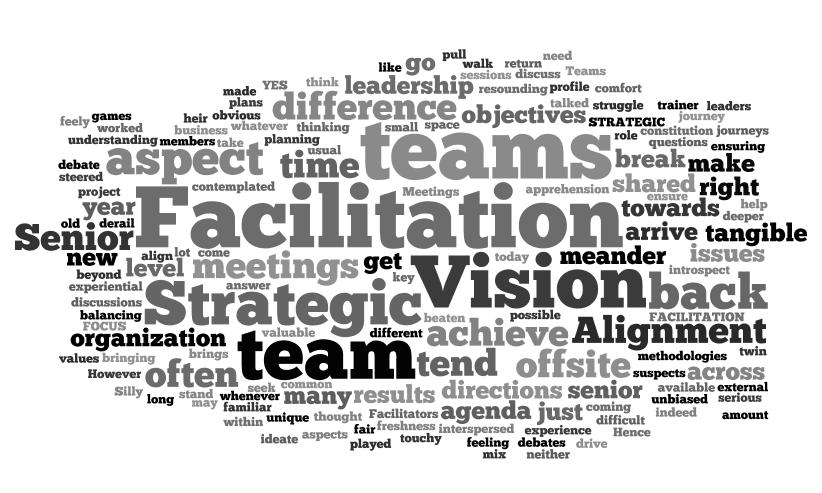I have been a trainer and facilitator for last 11+ years and have conducted a number of training programs successfully. Recently I got an opportunity to co-facilitate a Leadership training program with my colleague Mr. Kunal Chakrabarti wherein he was the lead trainer and I was second in command. This was my first ever co-facilitation program and I was little worried so I requested Mr. Chakrabarti to help and guide me as how can we make it a success. He helped me with various tips which actually helped me to run the program successfully. In this two series blog I’ll share my views on the art of Co-Facilitation, Advantages and Potential Disadvantages and how to master the art of Co-Facilitation.
What is Co-Facilitation?
Co-Facilitation is defined as, “Meeting or other group process by two or more persons in a cooperative, collegial manner to achieve a given outcome. Each facilitator is capable of assuming the lead role. Those not taking the lead role can support the lead facilitator in various ways.“
In their book, ‘Co-Facilitation’, Joana Knight and Warren Scott has write, “The distinguishing feature of co-facilitation is that it is intended to be a partnership, where two or more facilitators take joint responsibility for filling the facilitator role. The purpose of this partnership is either to enable and maximize group and individual learning, or to help the group to achieve other ends such a making a business decision.”
Three models of Co-Facilitation
- Alternate Leading: In this model each facilitator leads the part of the session. The alternating roles are decided at the time of the planning process.
- Shared leading: In this model the facilitators are not responsible for a specific session but they can chip in and flow out as per the need of the session. There are times when one facilitator might be in lead role and the other facilitator may chip in to explain a point or clarify any doubt. The key challenge in this model is sometimes the session is hijacked by the other facilitator giving no time to the facilitator to make his point.
- The Apprentice Model: In this one facilitator is more experienced than the other. The experienced facilitator takes the majority of the session allowing the apprentice (less experienced facilitator) to learn and practice safer activities. It builds the confidence of the less experienced facilitator as he knows there’s someone who can step in if things doesn’t go the way as planned.
Co-Facilitation enhances the possibility and outcome of group programs, ensuring the facilitation experience comes from a place where the sum totals more than the parts. While there are a no. of advantages of co-facilitation, there are some potential disadvantages also and if you are going to co-facilitate a session you need to consider both to avoid any dangers of ruining the session.
Advantages of Co-Facilitation
- Synergy: When people work together collaboratively and share their skills, resources and energy a synergetic effect often develops and usually the outcome of the deliberation exceeds the sum of individual contribution.
- Capitalizing on Strengths: Facilitators may have different styles and strengths and they can divide the session in a way that lets them to capitalize on their individual strengths.
- Lightens the Load: Co-facilitation eases the pressure of full responsibility. There’s a huge list of things which needs to be done before and during the session such as preparation, design, holding the space for the group, observing what is going on from a process standpoint and dealing with logistical issues.
- Robust Approach: It brings different approaches, attributes, energies, experiences, skills, styles and perspectives to the program and allow for a more robust approach.
- Enhanced Creativity: In co-facilitation different skill sets of the facilitators can be used to make the session more interesting by enhancing the creativity.
- Skill Development: Facilitating is a lonely activity and the opportunities for personal and professional development are less as usually the participants don’t give meaningful feedback on the facilitator competence. In Co-facilitation both the partners get feedback from each other for their work which in turn can help them to sort out the issues and become more proficient.
- Conserving Energy: It is very difficult to conserve your energy for a daylong session for a lonely facilitator. I remember falling ill during a training program and how hard it was to continue the session. Co-facilitator provides that breather to his peer facilitator where he can recharge himself and shine.
Potential Disadvantages of Co-Facilitation
- Egos: Sometimes the co-facilitators do not lean into the relationship equally and they try to dominate each other and their egos may get in the way of effective co-facilitation.
- Competition: Sometimes the co-facilitators may become competitive with each other and adopt competitive rather than collaborative approaches.
- May be stressful: Co-facilitation may be stressful as there may be mismatch of the styles of the co-facilitators. Co-facilitation may be stressful for the participants as they may have to adjust as per the styles of the facilitators.
- Time consuming: Co-facilitation can be time consuming as it does not only need only joint planning but also evaluation and feedback.
- Different Styles and Orientations: Co-facilitators may have different styles and different orientations- theoretical, technical and personal- potentially spoiling the effectiveness of each other.
- Overtraining: With highly energetic two or more facilitators sometimes overtraining is very likely due to too many interventions which stifle both participants and learning.
- Blind Spots: If Co-facilitators are same in their theory/ technique and approach they are very likely to have mutual blind spots in recognizing different dynamics. There’s a possibility that both the facilitators missing out significant learning opportunities.
This is first part of two part series on ‘The Art of Co-Facilitation’. In my next blog I’ll write about the ‘Tips for an awesome Co-Facilitation’.
